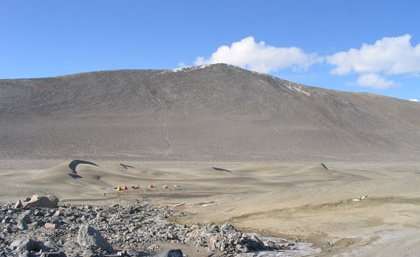Antarctic lakes theory dries up

(Phys.org) —Antarctica is the driest continent on Earth, and always has been, with new research showing the previous "mega-lake theory" holds no water.
Researchers from The University of Queensland have refuted previous theories that the Victoria Valley in Antarctica's Trans-Antarctic Mountains was filled with a mega glacial lake between 20,000 and 8000 years ago.
Associate Professor Hamish McGowan, from UQ's School of Geography, Planning and Environmental Management, said the research meant scientists could now more accurately interpret evidence of past climate and environmental change in the region.
"The McMurdo Dry Valleys of Antarctica are one of the driest places on Earth, thought to be similar to the conditions on Mars, and our research has shown a drier history than previously believed," Dr McGowan said.
"Our studies show the previously accepted mega-lake, estimated to be 200m deep and covering an area of 100km2, never existed.
"This changes our understanding of this unique landscape's climate history, and will impact on how future research into mega-lakes is conducted.
"A better understanding of the climate history will enable more accurate predictions of the future climate in the region."
Dr McGowan said the main evidence for the mega-lake hypothesis was the presence of landscape features interpreted as shorelines.
"Our research has shown that these features are actually evidence of an ancient mass movement of land and that accumulating enough water to generate a mega-lake would not have been possible at the time," he said.
"There are well-recognised paleoshorelines from other Antarctic lakes, but the shorelines proposed for Glacial Lake Victoria are not consistent.
"Our review of previous research also shows that accumulating such a large volume of water at that time, when temperatures were 8°C colder than present, would be extremely unlikely."
The UQ researchers used topographic surveys and cosmogenic dating of granite boulders to show that the proposed shorelines are actually the scars of an ancient collapse of the slope, which took place more than 300,000 years ago.
The results support other recent studies which have questioned the mega-lake hypothesis and found no evidence for the existence of a large body of water through soil studies.
The research is published in Geomorphology.
More information: Hamish A. McGowan, David T. Neil, Johanna C. Speirs, "A reinterpretation of geomorphological evidence for Glacial Lake Victoria, McMurdo Dry Valleys," Antarctica, Geomorphology, Volume 208, 1 March 2014, Pages 200-206, ISSN 0169-555X. dx.doi.org/10.1016/j.geomorph.2013.12.005.
Journal information: Geomorphology
Provided by University of Queensland




















